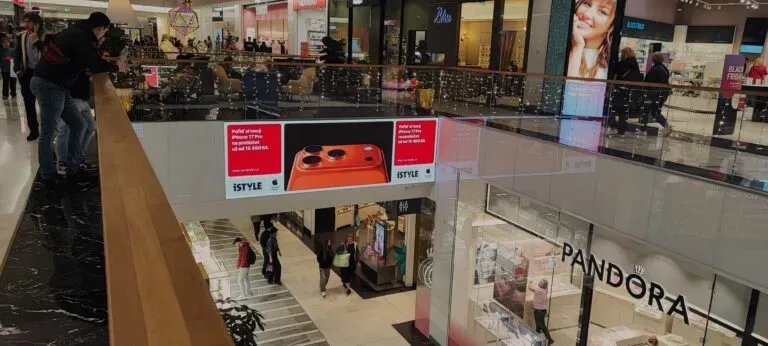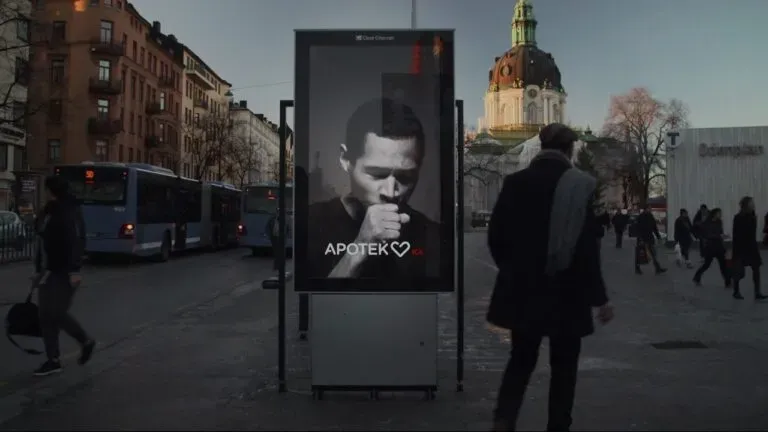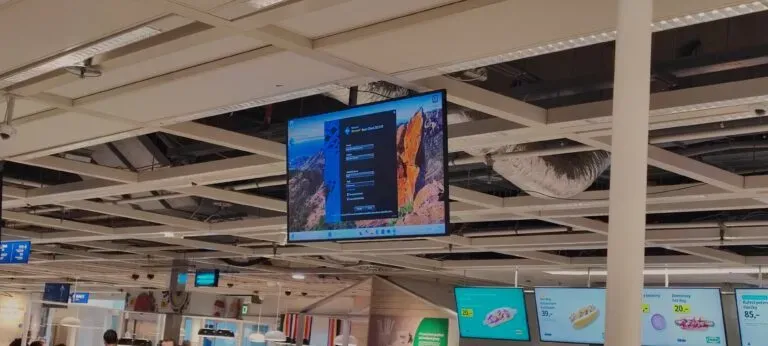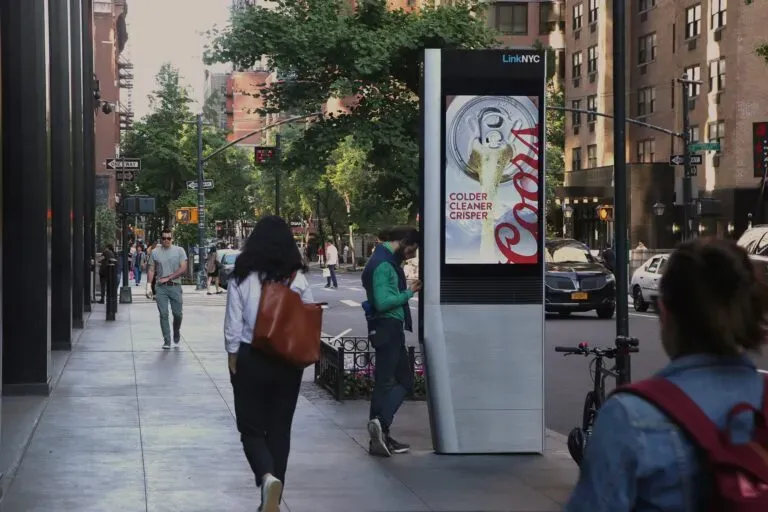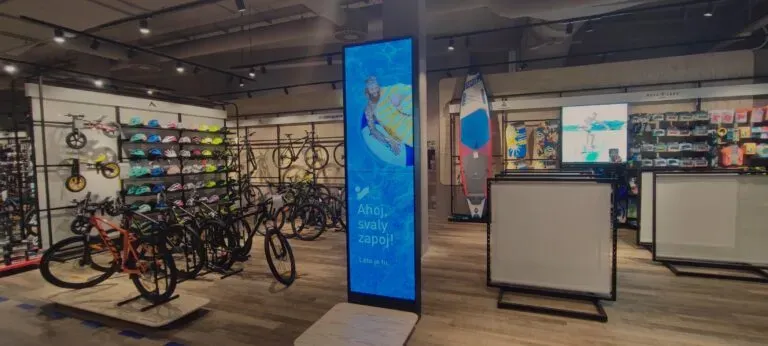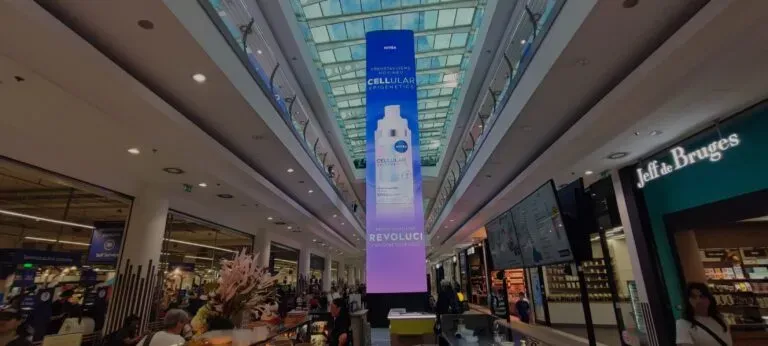DOOH: how in 2025 a developer can attract clients
DOOH today increasingly relies on modern digital solutions that combine classical tools with new technologies.
The new residential construction market is already overloaded with offers, competition has increased, and online click auctions are becoming ever more expensive. Against this background, outdoor formats are regaining importance, as they ensure a strong brand presence in urban space—something impossible to reproduce solely through online channels.
In large cities, outdoor surfaces, transport, entrance groups of metro stations, and modern LED video walls create a multi-layered contact with the audience. A person sees the message every day during regular movements, and this forms stable associations with the developer’s stability and scale. That is why DOOH advertising has become an important part of the city rhythm, where offline communications work on a level of trust that is difficult to gain through performance activities alone.
According to industry studies, developers’ investments in outdoor advertising have almost doubled in recent years. A significant role is played by the accuracy of location selection provided by modern DOOH networks, which allow for covering key areas around residential complexes. Visibility in urban space acts as a long-term informational layer that accompanies the buyer from the first contact to the actual visit to the sales department.
Goals and objectives of a developer’s offline marketing
In the real estate market, advertising almost never leads to an immediate inquiry. A future buyer studies alternatives for a long time, compares locations and layouts, discusses options with the family, and follows the economic situation. That is why the developer’s offline communications must perform several parallel functions, reinforcing each other.
First of all, it is the growth of awareness of the company and specific projects within the framework of competition. In addition, advertising should support the reputation of reliability, which is especially important against the backdrop of informational fluctuations in the real estate sphere. The next step is to lead the potential buyer to a target action: a call, a request for a consultation, or a visit to the showroom, where they can already evaluate the offer in person.
Research shows that outdoor advertising works best precisely in building trust and recognition. It is one of the key tools for brand building, ensuring the effect of repeated contacts. In combination with digital campaigns, this creates synergy in which several channels simultaneously lead the client to conversion. For example, when urban surfaces are reinforced with flexible tools such as Programmatic DOOH, the coverage result becomes even more stable.
While digital activities depend on auctions, algorithms, and creatives, outdoor advertising shapes the perception of scale and stability. In the business and premium segments, a constant presence in transport hubs, business districts, and locations with heavy daily traffic plays an important role. Thanks to this, branding in a DOOH campaign helps the developer demonstrate long-term presence and confidently consolidate the image of a strong player in the market.
Indoor advertising of a developer: working with “hot” flows inside premises
Indoor advertising is gradually becoming one of the key components of a developer’s marketing strategy, especially when the task is to attract potential buyers who are already close to making a decision. Indoor formats work where people stay longer and are more often in a focused state.
These are shopping and business centers, cinemas, fitness halls, food courts, office lobbies, elevator zones, as well as the developer’s own showrooms and marketing offices. In such spaces, advertising is perceived differently: research shows that content in shopping centers often has a higher level of attention than television or standard online banners.
For a developer, indoor communications perform a whole set of tasks. They become a continuation of the impression formed by outdoor surfaces and digital channels, strengthen trust through high-quality visuals, and allow showcasing projects in more detail than in the urban environment.
If a person has already developed interest in a residential complex, contact with an advertising message in places of daily visits can become the very stimulus that will lead them to the sales office within the next few hours.
Modern digital technologies operating indoors are of great importance. Today, the indoor environment is actively developing because LED screens and large video panels make it possible to display high-quality dynamic content, including layouts of residential complexes, courtyard visualizations, neighborhood infrastructure, and construction progress.
In marketing centers, these tools help emphasize the project’s advantages, show layouts, or highlight architectural features — things difficult to convey with static images.
Another digital technology tool is the Digital Signage system, which allows building a flexible content display scenario depending on location, time, and audience type. This is important for projects where different buyer segments come at different times of the day. Thanks to this, the developer can show broad overview videos during high-traffic hours and more detailed materials when visitors have more time to explore.
In certain areas of the indoor space, more personalized formats are also appropriate. Solutions such as interactive displays for buyers allow visitors to independently view layouts, choose a floor, see 3D visualizations, or learn about infrastructure. For the developer, this is a way to engage a person in a dialogue with the brand and give them control over the familiarization process — without pressure and at a comfortable pace.
An equally significant component is modern digital signage in retail, which organically integrates into the visual space of stores, galleries, and food courts. They operate at the intersection of emotional perception and the buyer’s rational interest, since placement in a familiar shopping environment helps perceive the residential complex as part of an established lifestyle. Such formats combine well with short calls to action and visual arguments that explain value advantages.
Indoor advertising also stands out for its high targeting accuracy. Thanks to the analytical capabilities of modern platforms, it is possible to take into account traffic on different days of the week, visitor behavioral patterns, and the interests of specific segments. This allows displaying separate creatives for office employees on weekdays or emphasizing family offers on weekends, when there are more young couples and parents with children in shopping centers.
Indoor advertising becomes especially effective in locations with large flows of people. Many modern shopping centers are no longer just commercial facilities — they include offices, entertainment zones, and even residential elements. This turns them into natural points of contact with those who are considering updating their housing or investing in real estate. In such conditions, advertising structures and screens allow immersing a person in the atmosphere of a new complex and creating an emotional connection with the project.
Indoor advertising gives another important advantage — more time for perceiving the message. When a visitor waits for an elevator, sits in a recreation area, or stands in line, they naturally respond to meaningful creatives: detailed layouts, infrastructure advantages, mortgage conditions, or promotions. Adding a QR code or a short, convenient URL to this gives the developer a measurable channel that helps convert interest into contact without unnecessary barriers for the potential buyer.
Outdoor advertising of a developer: billboards, boards, and supersites as the framework of presence
Classical formats of outdoor advertising remain the foundation of any developer’s marketing strategy. It is billboards, boards, and supersites that create a recognizable, dense, and stable visual contour around a residential or commercial project — a contour that is very difficult to ignore.
For the real estate market, this is critical, since a residential complex is tied to a specific territory, and the purchase decision is often formed within a particular district. International studies confirm that campaigns involving outdoor structures provide a noticeable increase in brand awareness and the number of inquiries, especially when placement is synchronized with digital channels and geographically tied to the project area.
Standard boards act as the basic layer of communication. They form “guides” at the entrances to the complex, stand on key streets of the district, and cover routes between business zones and residential quarters. Such advertising screens work on the effect of habit: the audience sees the same message daily, gradually remembers the name of the complex, and begins to perceive it as part of the urban environment.
It is important that the boards are located not only near the object but also along the main movement lines of potential buyers — near shopping centers, business hubs, metro stations, and transport interchanges.
Billboards on large highways and in key entrance points to the city work for a stronger image effect. Thanks to their large format, they allow for displaying panoramic images of residential towns, architectural renderings, atmospheric photos of the district, short offers, information about the start of sales, or special mortgage conditions.
Market practice shows that developers achieve the maximum result when the same message is repeated on several billboards along one route — this creates rhythm, enhances memorability, and influences the decision of the target audience.
Supersites occupy a special role in the media mix. These are large, premium surfaces with maximum visibility — at city entrances, near bridges, and along highways. Their task is not only to inform but also to form the brand’s status. For a business-class or premium-segment developer, presence on supersites is often a marker of reliability and scale.
Such structures work effectively both for an individual flagship project and for portfolio communication, when the developer’s brand and its key projects are promoted on the surface.
It is important that outdoor formats work in conjunction with digital tools. Large boards and supersites create the first contact and image level, while billboards and city boards near the object provide detailed information. At the same time, digital outdoor advertising (DOOH) in combination with SSP and DSP for DOOH allows increasing coverage, accuracy, and display frequency.
Thanks to programmatic purchasing, provided by the Supply-Side Platform and modern DSP solutions, a campaign becomes more flexible: it is possible to adjust creatives, change display schedules, and target the audience by behavioral characteristics.
Together with software for LED screens, this creates a seamless ecosystem where static advertising is complemented by dynamic messages and analytics.
Special attention should be paid to the quality of creatives. A person has only a few seconds to read the information, so each construction must have one clear focus. It can be a price offer, location advantages, emphasis on the developer’s reliability, a unique architectural feature, or special financial conditions.
Overloaded text or complex schemes reduce effectiveness. The best results come from clean visual solutions with one main message — they are easily remembered and continuously generate a flow of inquiries to the sales department.
When classical outdoor advertising and digital outdoor advertising (DOOH) work as a single system, the developer achieves maximum effect: direct calls from numbers on constructions, organic growth of branded search, increased website traffic, and more visitors to showrooms and marketing centers.
As a result, what is formed is not just an advertising campaign but a stable communication presence that is difficult to bypass even in a highly competitive environment.
Statistics: why DOOH is more effective than traditional OOH
1. Growth of programmatic DOOH
– According to VIOOH data, currently about 27% of DOOH campaigns include a programmatic component.
– This share is expected to grow to about 35% within the next 18 months.
– Budgets for pDOOH are often reallocated from other digital and traditional channels: 37% of advertisers plan to withdraw investments from other digital channels.
2. Advantages of the programmatic approach
– Flexibility: the ability to quickly change creatives depending on the time of day, context, or events.
– Dynamic Creative Optimization significantly increases campaign effectiveness.
– Programmatic DOOH is important for both brand and performance objectives.
3. Investments and advertisers attitudes
– 87% of media professionals in the United Kingdom plan to maintain or increase investments in programmatic DOOH during the next 18 months.
– In the Nordic countries (Finland, Sweden, Norway, Denmark), 32% of campaigns already use pDOOH — this is above the global average (~28%).
In conclusion, digital outdoor advertising (DOOH) today demonstrates greater effectiveness thanks to its flexibility, dynamism, and ability to fine-tune through programmatic tools. Advertisers increasingly choose DOOH not only as a modern alternative to classical OOH formats but as a channel that combines image influence with measurable results. That is why DOOH continues to grow worldwide and becomes a key element of media strategies for brands that value speed, precision, and technology.
Advision is a content management system for remote control, media planning of video and audio content broadcasting, and a supply-side platform for monetising advertising time. We also implement a Wi-Fi tracking system to measure quantitative indicators of the advertising audience.
We help Digital Signage owners and DOOH advertising operators earn money from advertising, automate work processes, and build a reliable media infrastructure using AdTech and MarTech software solutions.
Contact us if you want to increase your profits and implement the latest technologies to solve your problems!
Share the news


